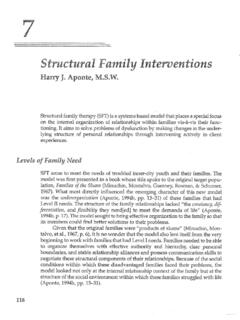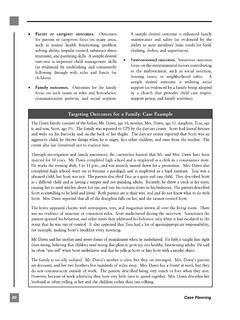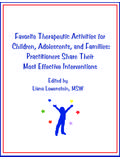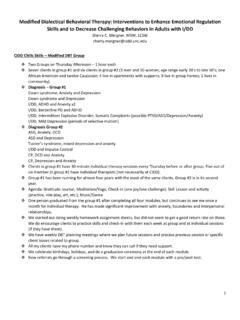Transcription of Murray Bowen’s Insights into Family Dynamics - Interventions
1 Bowen Theory Murray Bowen s Insights into Family Dynamics * Differentiation of Self or How to Get Your Own Life And Not Get Overwhelmed By Your Family The cornerstone of Bowen s carefully worked out theory is his notion of the forces within the Family that make for togetherness and the opposing forces that lead to individuality, autonomy, and a separate self. To Bowen, the degree to which a differentiation of self occurs in an individual reflects the extent to which that person is able to distinguish between the intellectual process and the feeling process (emotions) he or she is experiencing. Thus differentiation of self is related to the degree to which one is able to choose between having his or her actions, relationships and life guided by feelings or thoughts (what part of me is running my life my gut or my brain?)
2 Who is in charge - my feelings or my thinking?). Those individuals with the greatest fusion between the two function most poorly; they are likely to be at the mercy of involuntary emotional reactions and tend to become dysfunctional even under low levels of stress. Just as they are unable to differentiate thought from feeling, such persons have trouble differentiating themselves from others and thus fuse easily with whatever emotions dominate the Family . This is CODEPENDENCY one literally can t tell the difference between their thoughts and feelings and those of another person! Bowen introduced the concept of undifferentiated Family ego mass, derived from psychoanalysis, to convey the idea of a Family emotionally stuck together, one where a conglomerate emotional oneness .. exists in all levels of intensity (Your garden variety codependent Family !
3 For example, the symbiotic relationship of interdependency between mother and child may represent the most intense version of this concept; a father s * From Goldenberg, I. & Goldenberg, H. (1990). Family Therapy: An Overview. Pacific Grove: Brooks/Cole Publishing Company PLEASE NOTE: The following article is a modified version of a chapter in the book Family Therapy: An Overview, by Goldenberg and Goldenberg (1990). This article describes the psychiatrist Murray Bowen s view of Family systems and how individuals and families interact. It offers a theoretical perspective of Family Dynamics . The article has been updated to include the popular term codependence as well as the Family Dynamics often found in families where there are high levels of fusion and/or substance use.
4 I have liberally highlighted and added language in red to hopefully modernize the original writing which is sometimes pretty intellectual. I am grateful to the authors for allowing me to use their work. Larry Fritzlan, LMFT, CAS, BRI-1 2detachment may be the least intense. The degree to which any one member is involved in the Family from moment to moment depends on that person s basic level of involvement in the Family ego mass. Sometimes the emotional closeness can be so intense that Family members know each other s feelings, thoughts, fantasies, and dreams. This intimacy may lead to uncomfortable "overcloseness, according to Bowen, and ultimately to a phase of mutual rejection between two members (fights, slammed doors, phone hang-ups, etc). In other words, within a Family system, emotional tensions shift over time (sometimes slowly, sometimes rapidly) in a series of alliances and rejections.
5 What Bowen had initially characterized in psychoanalytic terms undifferentiated Family ego mass he later recast in systems language as fusion-differentiation (codependent-healthy separateness). Both sets of terms underscore Bowen s insistence that maturity and self-actualization demand that an individual become free of unresolved emotional attachments to his or her Family of origin. (If one wants to become an adult they must cut the cords with the other Family members. This requires that we establish meaningful contact with important others outside of the Family , , therapists, 12 Step sponsors, counselors, healthy supportive mentors, etc.) For illustrative purposes, Bowen proposed a theoretical scale for evaluating an individual s differentiation level. The greater the degree of undifferentiation (no sense of self or a weak or unstable personal identity), the greater the emotional fusion into a common self with others (the undifferentiated Family ego mass - codependency).
6 A person with a strong sense of self ( These are my opinions .. This is who I am .. This is what I will do, but not this .. ) expresses convictions and clearly defined beliefs. Such a person is said by Bowen to be expressing a solid self. He or she does not compromise that self for the sake of marital bliss or to please parents or achieve Family harmony, or through coercion. Another example is a parent who will not enable an addict to continue to use drugs or alcohol. 0 25 50 75 100 Undifferentiated Differentiated Codependent Codependent in recovery Alcoholic/Addict Alcoholic/addict in recovery Dysfunctional Functional Fused/ Enmeshed Self actualized Unhealthy Healthy Triggered, evoked.
7 Freaking out Rational under stress Emotionally immature Emotionally Mature Parent/Child relationships Adult/Adult relationships False Emancipation Emancipation CGAS* 80 or less CGAS 81 or higher GAF* 80 or less GAF 81 or higher (* See page 9 for information on CGAS) People at the low extreme are those whose emotions and intellect are so fused that their lives are dominated by the feelings of those around them. ( My child is experiencing difficulty, I need to rush in and save them. ) As a consequence, they are easily stressed into dysfunction. Bowen considers them to be expressing a pseudo self, which they may deceive 3themselves into thinking is real but which is composed of the opinions and values of others (codependency).
8 Those far fewer individuals at the high end are emotionally mature; because their intellectual or rational functioning remains relatively (although not completely) dominant during stressful periods, they can take action independent of the emotionality around them. In the midrange are persons with relative degrees of fusion or differentiation. Note that the scale eliminates the need for the concept of normality. It is entirely possible for people at the low end of the scale to keep their lives in emotional equilibrium and stay free of symptoms, thus appearing to satisfy the popular criteria for being normal. However, these people are not only more vulnerable to stress than those higher on the scale, but also, under stress, are apt to develop symptoms from which they recover far more slowly than those at the high end of the scale.
9 According to Bowen, any person s level of differentiation reflects that individual s level of differentiation from the Family as well as from others outside the Family group. A moderate-to-high level of differentiation permits interaction with others without fear of fusion (losing oneself in the relationship, becoming triggered, codependency. You make me angry is an example of this loss of self). While all relationships ranging from poorly to well-differentiated ones are in a state of dynamic equilibrium, the flexibility in that balance decreases as differentiation decreases. (The more together we are and the more recovery we have result in us being less triggered by others.) Bowen s theory assumes that an instinctively rooted life force in every human propels the developing child to grow up to be an emotionally separate person, able to think, feel, and act as an individual.
10 At the same time, Bowen proposes that a corresponding life force, also instinctively rooted, propels the child and Family to remain emotionally connected. As a result of these counterbalancing forces, argues Bowen, no one ever achieves complete emotional separation from the Family of origin. However, there are considerable differences in the amount of separation each of us accomplishes, as well as differences in the degree to which children from the same set of parents, emotionally separate from the Family . The latter is due to characteristics of the different parental relationships established with each child, as we intend to elaborate later in this section. Triangles or Rather Than Grow Up Ourselves, Let s Try To Fix Someone Else In addition to its interest in the degree of integration of self, Bowen s theory also emphasizes anxiety or emotional tension within the individual or in that person s relationships.







